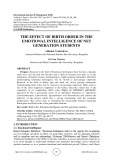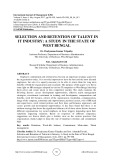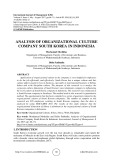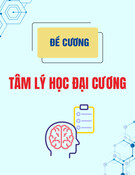
http://www.iaeme.com/IJM/index.asp
19
editor@iaeme.com
International Journal of Management (IJM)
Volume 8, Issue 2, March – April 2017, pp.19–28, Article ID: IJM_08_02_003
Available online at
http://www.iaeme.com/ijm/issues.asp?JType=IJM&VType=8&IType=2
Journal Impact Factor (2016): 8.1920 (Calculated by GISI) www.jifactor.com
ISSN Print: 0976-6502 and ISSN Online: 0976-6510
© IAEME Publication
LEADERSHIP OF THE FUTURE
Sanchita Raghav
Assistant Professor, Amity University Haryana, Gurgaon, India
Dr. Sanjeev Kumar
Assistant Professor, Amity University Haryana, Gurgaon, India
Ninad Chandrayan
B.Plan, Amity University Haryana, Gurgaon, India
Mohan Gautam
B.Tech, Amity University Haryana, Gurgaon, India
Ankit Tiwari
Research Scholar, Amity University Haryana, Gurgaon, India
ABSTRACT
On the one hand, when leadership manifests itself, the roles assumed by the leader
are extremely important, but, on the other hand, the roles assumed by the members of
an organisation are important as well. “Shaping” the future is made starting from
several variables: the evolution of technology, the cultural conflicts, the uneven
economic developments, the diversity of contexts which very often do not depend on
“actors”, the quality of political leaders, and the complexity of social problems that
arise. In light of these variables, leadership can play a decisive role to the extent that
suitable individuals appear in crisis situations, individuals who use a visionary and
creative leadership which is influenced by the values in which people find themselves.
We can speak of a favourable direction in terms of development to the extent that the
leadership has the ability to influence social groups to act in a certain way as to
achieve certain goals shared by the group. The aim of our paper is to present some of
the current concerns regarding leadership and its evolution in relation to the
evolution of society in general starting from the dramatic changes occurring in the
economic, social, political, technological and cultural fields and also to highlight
some of the future directions of leadership. The research methodology is based on
literature review.
Key words: action, attitude, development, leadership, vision

Sanchita Raghav, Dr. Sanjeev Kumar, Ninad Chandrayan, Mohan Gautam and Ankit Tiwari
http://www.iaeme.com/IJM/index.asp 20 editor@iaeme.com
Cite this Article: Sanchita Raghav, Dr. Sanjeev Kumar, Ninad Chandrayan,
Mohan Gautam and Ankit Tiwari, Leadership of the Future. International Journal of
Management, 8 (2), 2017, pp. 19–28.
http://www.iaeme.com/IJM/issues.asp?JType=IJM&VType=8&IType=2
1. INTRODUCTION
The world of the future defines its mark through sometimes imperceptible changes of today
which anticipates the future. The frequency, speed and importance of changes influence in a
decisive way people’s trajectory, but also the social groups’ and society’s trajectory. We
observe that very often certain personalities create system architectures whose way of
operating influence in a decisive way the economic and social systems (Benoit, 2007).
Leadership represents everyone’s problem and, even if one of us has a personal response
method, when finding ourselves in situations of professional and social commitment certain
roles are being imposed to us, roles that we must assume. Even in situations when we are not
leaders, we can influence the others so that in a prompt and precise manner we can play the
role of informal leaders. As we have entered into a new era for business, leadership has
continuously changed and will change even more in the future. There are several forces that
are driving this change such as globalization, the rise of complex challenges, a world of
interruption, the acceleration in the scope, scale and economic impact of technology, and
leadership for longevity (Martin, 2007; Dobbs, Manyika and Woetzel, 2015).
However, the effectiveness and efficiency will remain the basic characteristics of
leadership. But they are not the only components of a powerful leadership because without the
ethical dimension, it would lose its essential meaning. Leadership of the future will set itself
up in a system of values that will require and impose a new type of leadership that will use
power in favour of the individual, group and organization. Therefore, a high character and
ethical leadership is needed (Allio, 2009; Ehrich et al., 2015; Leavy, 2016), a leadership
marked by humanitarian values because current technology offers each individual the
opportunity to learn and to know, to be permanently informed. On the other hand, some
authors believe that the development of emotional intelligence plays an important role in
defining a participatory leadership where self-direction represents a permanent compass for
the individual and for the group as well (Yeung, 2006). In fact, leadership is "a relational
process involving interaction with a range of stakeholders and structures" (Duckett,
Macfarlane, 2003, p. 310). From this perspective we can speak of an organizational
intelligence and an individual intelligence.
The evolution of the concept of leadership (the authentic leadership, the transformational
leadership, the ethical leadership, the cognitive leadership, the transactional leadership, the
participatory leadership, the intercultural leadership - Avolio, Walumbwa, Weber, 2009) leads
to the idea that the emergence of e-leadership is foreshadowed due to the new technologies.
This concept defines “virtual realities” which may represent a variety of possible directions
that are established in relation to the leaders’ decisions within the nodes of a network. E-
leadership is closely related to virtual organizations (network organizations) that will define
another reality where its employees can be at great distances but they can also make decisions
at the level of a network node or the network itself. In such conditions we can talk of a
leadership distributed across all nodes within the network with changing the centre of decision
from a node to another in relation to the needs of the network. In the virtual teams challenges
are “more likely to occur when distributed work occurs in different time zones, when local
communication and human infrastructures fail, when team members’ hardware and software
platforms are different, or when local work demands require the immediate attention of
collocated managers and workers, thereby creating pressure to pursue local priorities over the

Leadership of the Future
http://www.iaeme.com/IJM/index.asp 21 editor@iaeme.com
objectives of distant collaborators” (Weisband, 2008).Connexion and rankings are contrived
to design effective university report cards. This encapsulates validity of measures,
extensiveness of measures, unambiguousness and relevance of information for students,
proficiency of rankings proportionality to convalesce teaching and student learning (Raghav,
S., Tiwari, A., Gautam, M., Arya, K.S., Raghav, Y., & Thakran, A., 2016).
We must keep in mind that leadership focuses not only on the behaviour of the leader, but
also on the behaviours of the individuals within a group in relation to the context, culture, the
whole spectrum of diversity and social dynamics.
The aims of our paper are to present some of the current concerns regarding leadership
and its evolution in relation to the evolution of society in general starting from the dramatic
changes occurring in the economic, social, political, technological and cultural environments
and also to highlight some of the future directions of leadership. The research methodology is
based on literature review.
2. THE PERSPECTIVES OF LEADERSHIP
In the evolution of leadership changes will occur, changes that are being influenced in a
decisive way by the relation between the corporation as a network and clients who, in turn,
are part of a variety of other networks. Thus, an inevitable closeness is occurring between the
client and the corporation so that, on the one hand, products and services will be customized
and, on the other hand, decisions may be taken in relation to reality even by members of the
corporate network. In this regard, Beaubien’s remark is very illustrating “as technological
advances make answers easy to find, companies will reward leaders who ask the right
questions. Fast, market-based decisions will trump top-down leadership hierarchies, with
decision-making authority extending to the edges of the organization, where employees are
closest to customers and work directly in partnership with them” (Beaubien, 2014).
In the evolution of the companies of the future and the society in general, one must
establish an optimal balance between leadership and management, on the one hand and
between leader and manager, on the other hand. Starting from the conceptual boundaries that
exist between effectiveness and efficiency, one must clearly establish the action areas of
leadership and the action areas of management. Apparently, there is not a great distance from
vision to allocation of resources, but such relationship is translated into appropriate
behaviours which define modes of action and reaction of the leader, on one hand, and the
manager, on the other hand. Clearly, at the level of an organization, the manager must also
own leadership qualities because in extreme situations in which the leader finds himself
permanently he cannot limit his activity only in the allocation of resources. He has to have
vision and, at the same time, he must also be convincing. MacPhearson’s observations, “... is
leadership enough? The simple answer is no! We need management to execute the day-to-day
missions and we need leadership to weather the storms (which seem to be continuous and
ever-changing)” (MacPhearson, 2015) are enlightening in relation to the complementarity of
the leadership and management as forms of manifestation and in relation to the way in which
decisions can be taken within the organizations of the future by each member of the network
compared to the existing needs.
The society of the future will be subject to pressures that often are not anticipated. The
process of preventing the extreme situations or the process of adapting thereof will require a
new type of behaviour of the individual and the organization simultaneously. It will require
quick adaptation, creating new competences, preventing or managing conflict situations and,
not ultimately, changing the value systems. We can talk about situations where real
“collisions” between the personal (individual) value systems and the organisational value
systems may occur. Such situations remind us of the process of natural selection. In fact, this

Sanchita Raghav, Dr. Sanjeev Kumar, Ninad Chandrayan, Mohan Gautam and Ankit Tiwari
http://www.iaeme.com/IJM/index.asp 22 editor@iaeme.com
is about the rapid adaptation of the individual and the organisation to those situations in which
they find themselves, situations that, in most cases, are not caused by them. The process of
changing the organizational culture becomes a necessity when stakeholders require rapid
change. The vision and the strategies of the organization must be made compatible with the
new culture implemented. Within this “game”, motivating people is essential as it may
enforce a type of conduct for each of the employees so that organizational objectives are
achieved - an idea shared by Seraina Maag as well who says that “...there are so many
takeaways but, for me, the theme that really stands out is the importance of changing
organizational culture. Achieving genuinely diverse leadership in business takes more than
just token gestures: it needs a change of mind-set from the top down”. (Seraina, 2015).
Leadership also means the inspiring and charismatic behaviour in which moral values are
clearly defined and permanently applied and the management is seen as a permanent
transformation where the challenge of each individual, but also the permanent intellectual
stimulation represent genuine rules. Given that the spirit of leadership stands for values,
attitudes and behaviours which are essential for motivating individuals, we can speak of “a
sense of spiritual survival through calling and membership”. (Fry, 2003).
Making leadership compatible with the new value system must take into account the
traditions of the group, the relationships that are established within, the aspirations and, not
least, the identity of each individual and, at the same time, the identity of the organization.
Here, we can refer to the brand of a company, but also to the brand of an individual as
well. The representation component is extremely important because, on the one hand, it has a
motivating character, and on the other hand, it contributes to the enhancement of the
credibility of the organization and, accordingly, of the products and services that such
organisation provides. The quality of relationships reveals both the content of internal
relations, as well as the shades of the external relations (for example: suppliers, beneficiaries,
banks, public institutions, etc.). At the level of multinational companies, traditions play an
important role because the network of each multinational company includes ways in which
employees with different traditions, different value systems, diverse experiences and often
unpredictable expectations develop themselves.
The scheme presented below provides information about the shades of possible
combinations between levels (very high, high, moderate, low) of the four parameters
(traditions, relationships, aspirations and identity).
In the paper Leadership and the Art of Struggle, Snyder's findings regarding the possible
combinations of the four parameters at the level of some internationally recognized
companies (Deloitte, Microsoft, General Motors, Apple, Boston Scientific Corporation,
Pentair) are interesting. From this, it results that changing one of the four parameters from the
maximum level to the inferior levels may create imbalances at the level of the other
parameters as well. In fact, here we can talk about “a fine-tuning” that makes the difference
between success and failure. Such changes which are apparently imperceptible must be made
as a result of an analysis (SWOT, Stakeholders, Environment) which set, at a certain moment,
the real relationships between “the combatants”. Leadership is the “Art of Struggle” (Snyder,
2013).

Leadership of the Future
http://www.iaeme.com/IJM/index.asp 23 editor@iaeme.com
Figure 1 Leadership Tension Map
Source: Snyder (2013, p.67)
The leader of the future must be like a conductor in an orchestra knowing very well the
competences of each employee, harmonizing such competences, implementing visions and
convincing people in relation with the direction of evolution of the organization. Actually,
“...the CEO of the future’s role will be to integrate these capabilities, to ensure that everyone
helps build and sustain them, and to keep everything working in a highly refined system”.
(Favaro, Karlsson and Neilson, 2015)
Refining the system means inclusively its connecting to the global network where it can
influence and where it can be influenced as well. Nowadays we discover that companies like
Facebook and Google use these “puzzle” elements offering a significance to each component
of the picture and, at the same time, engaging them in a unitary whole (here we can speak of a
synergistic vision and, at the same time, a systemic vision). These searches do not always
mean the best solutions. Sometimes, syncope arises and they are accompanied by conflicts
and this is the main reason why it is so important that the monitoring, control and assessment
process at the level of systems to work flawlessly. The quality of relationships is also due to
the consistency of the communication process. Within such, the entropy, redundancy and
feedback represent essential factors that support the process of achieving the objectives.
In his work, “Value systems and the future of leadership’", Stephen Bungay ascertains
that leaders “turn plans into actions and results”. (Bungay, 2011) The gaps mentioned by the
author are in close relation to plans, actions and results. The gap between plans and results is
influenced by knowledge; therefore knowledge management can contribute to decrease this
gap. The gap between plans and actions is influenced by alignment; such gap may be
decreased if there is synchronization between what we want to achieve and what we
accomplish in reality. The gap between actions and results is influenced by effects: here we
consider the ratio of what we hope to achieve and what we accomplish in reality.











![Tài liệu Tâm lý học lâm sàng trẻ tự kỷ [chuẩn nhất]](https://cdn.tailieu.vn/images/document/thumbnail/2025/20251205/namthangtinhlang_04/135x160/79221764992570.jpg)



![Câu hỏi ôn tập Tâm lý học quản lý [chuẩn nhất]](https://cdn.tailieu.vn/images/document/thumbnail/2025/20251125/hathunguyen04er@gmail.com/135x160/25191764124376.jpg)
![Cẩm nang chăm sóc và nuôi dạy trẻ tăng động giảm chú ý [chuẩn nhất]](https://cdn.tailieu.vn/images/document/thumbnail/2025/20251118/kimphuong1001/135x160/4241763431998.jpg)


![Sổ tay Hướng dẫn tự chăm sóc trầm cảm [chuẩn nhất]](https://cdn.tailieu.vn/images/document/thumbnail/2025/20251029/kimphuong1001/135x160/3711761720335.jpg)
![Đề cương Tâm lý học xã hội [chuẩn nhất]](https://cdn.tailieu.vn/images/document/thumbnail/2025/20251028/c.dat0606@gmail.com/135x160/99271761707421.jpg)
![Câu hỏi ôn thi Nhập môn khoa học nhận thức [chuẩn nhất]](https://cdn.tailieu.vn/images/document/thumbnail/2025/20251021/aduc03712@gmail.com/135x160/48471761019872.jpg)

![Đề cương môn Tâm lý học sinh tiểu học [chuẩn nhất]](https://cdn.tailieu.vn/images/document/thumbnail/2025/20251007/kimphuong1001/135x160/51781759830425.jpg)


